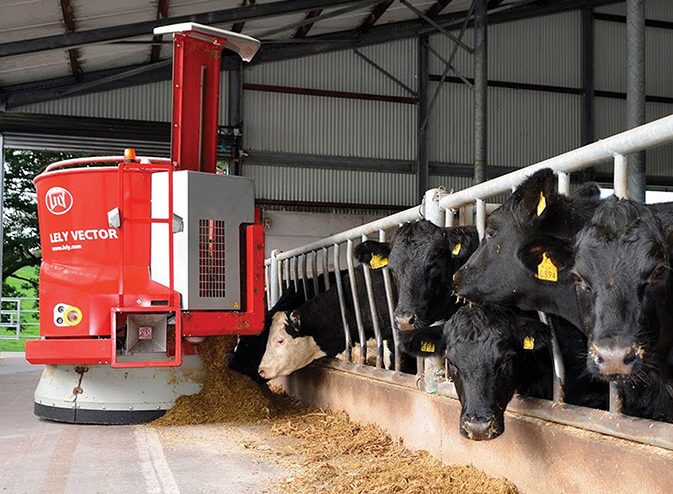
Few farms in Ireland, if any, have embraced modern technology quite like Glen South Farm in Banteer, Co. Cork which was the first beef farm in Europe to introduce the innovative Lely Vector Feeding System in January 2014.
Glen South Farm, which is owned by Frank Murphy, CEO of Monex Financial Services in Killarney, is a specialised finishing unit which supplies between 1,300 and 1,700 high-end cattle to the ABP processing facility in Rathkeale on an annual basis. Since 2012, when Frank and his wife Teresa took ownership of the farm, over €1.5 million has been invested in rebuilding the housing and animal handling facilities as well as in the Lely robotic feeding system. Since its installation, Glen South has been used as the standard bearer when it comes to robotic feeding systems throughout the world and has hosted a number of Lely Feeding open days, which have given farmers the opportunity to see the state-of-the-art system in operation.
“Lely invited Frank over to Holland for a demonstration and he was so impressed that he decided to have the automated system installed and designed the sheds around it,” farm manager Aine Sweeney remembers.
“It was a big investment (€125,000) at the time, but has enabled us to make big savings in terms of labour and fuel costs. It costs just €5.25 a day to run it and has attracted huge interest from right across the country.”
The Vector Feeding System achieves high growth rates with the cattle gaining approximately 1.3kg a day on the diets fed through it. The cattle, which are mostly Aberdeen Angus and Whitehead heifers, are fed on a diet consisting of maize silage, whole-crop silage and concentrates. The concentrate component is added to balance both the energy and protein available in the diet.
The robot follows four routes on the farm and concrete yards are critical for the machine to be fully utilised as it’s mounted on three wheels and uses ultrasonic sensors to track its route. The system installed on the Glen South Farm was designed with a kitchen area and crane to maximise the machine’s performance. The feed is stored in the feed kitchen, an open area without any obstacles, in which the maize silage and whole-crop silage are stored. A grab moves over the feed kitchen to select the feed and loads it into the mixing and feeding robot. After filling, the robot mixes the contents for five minutes before distributing it out to the animals in the yard.
The robot also knows how much feed there is in front of the cattle at all times and determines when and where feed is required, without any intervention from the farmer being required. It gives detailed information on the amount of feed given to each group of animals while also ensuring that they’re never short of feed.
“The Vector feeds on demand,” Aine explains.
“It feeds small amounts all day long, so the cattle are never hungry, which makes for a very relaxed and stress-free atmosphere, and the food is always fresh. It scans the height of the feed in front of them, pushes in the feed and if there is a pen that needs to be fed, it will go back in and fill for that pen. I would recommend the Vector to any large beef farmer.”
Glen South Farm buys heifers at 450kg from a number of local sources and finishes them to weights of 550kg liveweight, or 270-280kg deadweight, within a 70-day period. The farm has housing facilities for 360 store cattle, which are divided into 10 pens of 36 units during their stay.
“We insist on a 70-day turnaround because it doesn’t pay to keep them any longer,” continues the affable farm manager, who is ably assisted by Declan Barrett.
“After a period of trial and error, we have come up with a system that works well for us. The cattle are bought in at 450kg and are sent to the factory at 550kg 70 days later, aged between 22 and 24 months. We also insist on Angus and Hereford heifers because they’re easier to finish.”
Committed to producing beef of the highest quality, Glen South Farm is focused on the wellbeing and welfare of its stock as well as controlling the impact on the environment. The farm consists of 300 acres, of which 200 is used for grazing and the other 100 for growing whole-crop silage. James Hegarty in nearby Mallow is contracted to grow maize for the farm.
Glen South’s legacy stretches back to the early 1900’s where the O’Connell / McSweeney family has farmed for three generations. The family worked hard over the years to gather a wealth of farming knowledge. Traditional practices played an important role in maintaining sustainable production systems long before the days of modern farm machinery and technology.
The late Jeremiah McSweeney and his wife Margaret, who still lives on the farm, steadfastly upheld the farm’s traditions until 2012 when Margaret passed the baton to her daughter Teresa and husband Frank. After illness forced him to switch from dairy to suckler farming in 1985, Jeremiah won the regional award for excellence in his suckler herd two years later.
Now, with the assistance of technology, Glen South continues to prosper, maintaining due care to the land and animals while ensuring on-target profit delivery and future success for the next generation. A highly successful businessman, Frank Murphy has reviewed all areas of the enterprise, evaluating input while maintaining and improving current production levels.
Glen South Farm
Banteer,
Co. Cork.
Telephone: +353 (0)64 66 30630
Email: [email protected]
Taken from Irish Tractor & Agri magazine Vol 5 No 3, April/May 2017